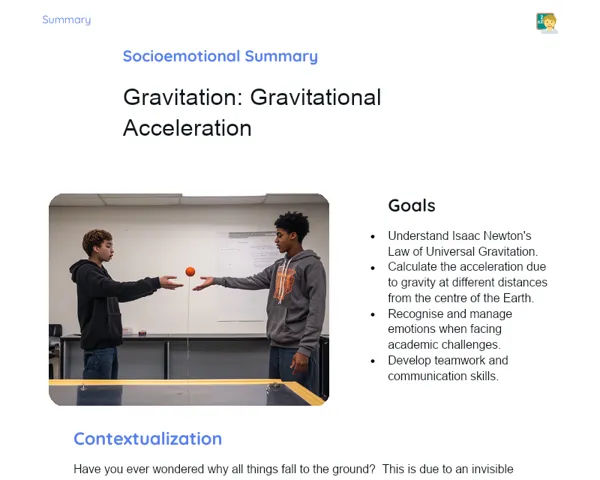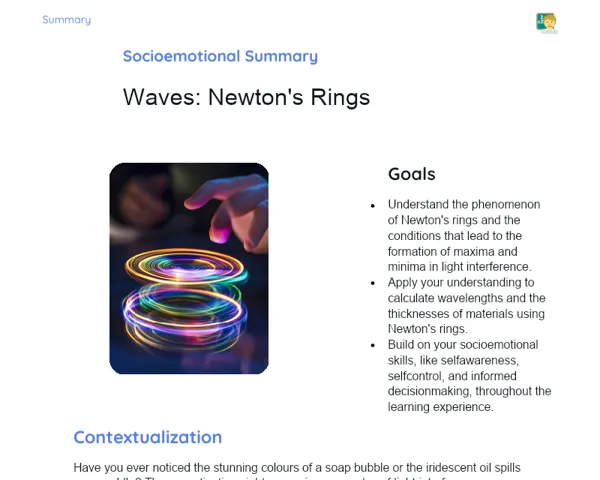Summary Tradisional | Magnetic Field: Wire
Contextualization
A magnetic field is the area around a magnet where magnetic forces can be felt. When electric current flows through a wire, it creates a magnetic field around it. This is a basic principle that has numerous applications in today’s technology, including electric motors, generators, and transformers. Understanding the magnetic fields produced by electric currents is crucial for the development and operation of various technological devices that we use every day.
The process of generating a magnetic field around a wire carrying electric current is explained by the Biot-Savart Law. This law gives us a mathematical way to figure out the strength of the magnetic field based on the amount of current in the wire and the distance from that wire to the point we’re interested in. Additionally, the direction of the magnetic field can be determined using the right-hand rule, a handy method for visualizing how magnetic field lines wrap around the wire. Getting a grip on these ideas is key for tackling problems involving the interplay of electric currents and magnetic fields, helping us apply these principles effectively in real-world situations.
To Remember!
Biot-Savart Law
The Biot-Savart Law is an essential equation in physics that illustrates how an electric current generates a magnetic field. It sets out a connection between the current moving through a conductor and the magnetic field created at a particular point in space. The formula used in the Biot-Savart Law is B = (μ₀ / 4π) * ∫(I dl × r̂ / r²), where B is the magnetic field, μ₀ is the magnetic permeability of free space, I is the current, dl is an infinitesimal wire segment, r̂ is the unit vector pointing to the point of interest, and r is the distance from that point to the wire.
The significance of the Biot-Savart Law lies in its ability to accurately predict the strength and direction of the magnetic field in various current arrangements. This is especially useful in complex scenarios where the shape of the conductor is not straightforward, like coils or circuits with odd shapes. The law also helps us see how factors like the current’s strength and the distance from the wire influence the magnetic field.
Utilizing the Biot-Savart Law allows us to determine the magnetic field around wires of different configurations, from straight wires to coils or loops. This is crucial for designing devices that depend on magnetic fields, like electric motors and transformers. The law is also applicable on a larger scale, such as in studies of planetary and solar magnetic fields.
-
The Biot-Savart Law describes the link between electric current and magnetic fields.
-
The formula includes current, wire length, and the distance from the point of interest.
-
It applies in lots of different current configurations, making it essential for designing electromagnetic devices.
Magnetic Field of a Straight Wire
The magnetic field created by a straight wire carrying current can be calculated using a simplified equation from the Biot-Savart Law. In this case, the formula is B = (μ₀ * I) / (2π * r), where B is the magnetic field, μ₀ is the magnetic permeability of free space, I is the current in the wire, and r is the distance from the point of interest to the wire.
This formula is derived by considering the symmetrical arrangement around the wire, where the magnetic field is the same along concentric circles. This significantly simplifies calculations for long, straight wires, enabling us to quickly determine the strength of the magnetic field at any point around the wire.
Knowing how to calculate the magnetic field of a straight wire is fundamental for addressing practical issues in physics and engineering. For example, in designing power transmission lines, it’s vital to understand the strength of the magnetic field around the wires to ensure system safety and efficiency.
-
The formula B = (μ₀ * I) / (2π * r) calculates the magnetic field of a straight wire.
-
The magnetic field is consistent along concentric circles surrounding the wire.
-
These calculations are important for practical uses, such as power transmission lines.
Right-Hand Rule
The right-hand rule is a practical method for determining the direction of the magnetic field around a wire that carries current. To use it, position your right hand so your thumb points in the direction of the current, and your fingers will curl in the direction of the magnetic field lines around the wire.
This rule is very useful for visualising and understanding how magnetic field lines are oriented around conductors. It can also be applied to various current configurations, such as in coils and spirals, helping predict the direction of the resulting magnetic field.
Proper use of the right-hand rule is essential for solving problems in electromagnetism, especially those that involve multiple current-carrying conductors or analysing magnetic fields in complex devices.
-
The right-hand rule helps determine the magnetic field direction around a current-carrying wire.
-
Position your thumb in the direction of the current, and your fingers will show the magnetic field direction.
-
It’s crucial for visualising and solving problems involving magnetic fields.
Practical Applications
The magnetic field created by a current-carrying wire has several practical uses in modern technology. One of the most common applications is in electric motors, where electric currents within coils create magnetic fields that interact with magnets to generate movement. This principle is the foundation of nearly all electric motors, from small gadgets like fans to large industrial equipment.
Another significant application is in transformers, which use magnetic fields to transfer electrical energy between different circuits. This happens through coils wrapped around a magnetic core, where the current in one coil generates a magnetic field that induces current in the other coil. This principle is essential for the efficient distribution of electrical energy across high-voltage networks.
Magnetic storage devices, like hard drives and magnetic tapes, also rely on the magnetic field produced by electric currents to record and retrieve data. In these devices, small currents shift the orientation of tiny magnetic areas, which can be read later to access the stored information.
-
Electric motors utilise magnetic fields from currents to create motion.
-
Transformers rely on magnetic fields to transfer electrical energy between circuits.
-
Magnetic storage devices use magnetic fields from currents to record and read data.
Key Terms
-
Magnetic Field: The area around a magnet or electric current where magnetic forces are observable.
-
Electric Current: The flow of electric charges through a conductor.
-
Biot-Savart Law: The formula describing the magnetic field produced by an electric current.
-
Magnetic Permeability (μ₀): A physical constant that measures how much a material can be magnetised.
-
Right-Hand Rule: A method for determining the direction of the magnetic field around a wire with current.
-
Electric Motor: A device that converts electrical energy into movement using magnetic fields.
-
Transformer: A device that transfers electrical energy between circuits using magnetic fields.
-
Magnetic Storage Device: Technology that employs magnetic fields for recording and reading data.
Important Conclusions
Studying the magnetic field produced by wires carrying current is essential for understanding various phenomena and technological devices. The Biot-Savart Law provides the mathematical groundwork for calculating and predicting the strength and direction of magnetic fields, facilitating the development of practical applications like electric motors and transformers. The right-hand rule is a vital resource for visualising the direction of magnetic field lines surrounding electrical conductors.
Being able to resolve problems related to the magnetic field from current-carrying wires is a key skill in physics and engineering. Real-world applications of this theory, such as in magnetic storage devices and power transmission systems, highlight the importance of the knowledge gained. Understanding these principles is critical for innovation and technological progress.
We urge students to explore electromagnetism further, looking into other configurations of conductors and their applications. Continuing this exploration will provide a wider and deeper understanding, enabling students to apply these principles in diverse and innovative contexts.
Study Tips
-
Revise the fundamental concepts of magnetic fields and electric currents to solidify the theoretical base.
-
Practice solving problems using the Biot-Savart Law and other relevant equations to build confidence and precision in calculations.
-
Look into additional resources like videos and scientific articles to enhance visualisation and understanding of the practical applications of magnetic fields created by electric currents.



